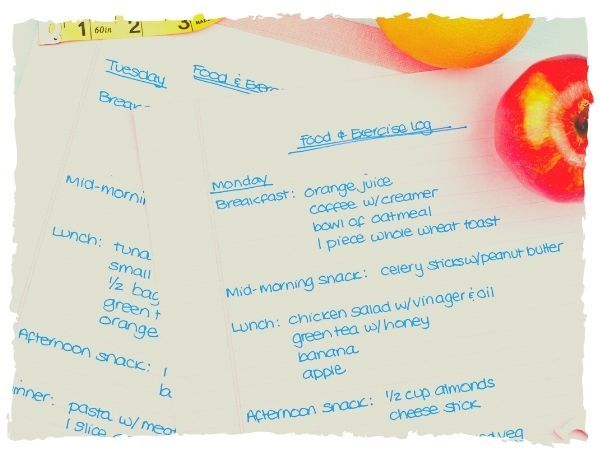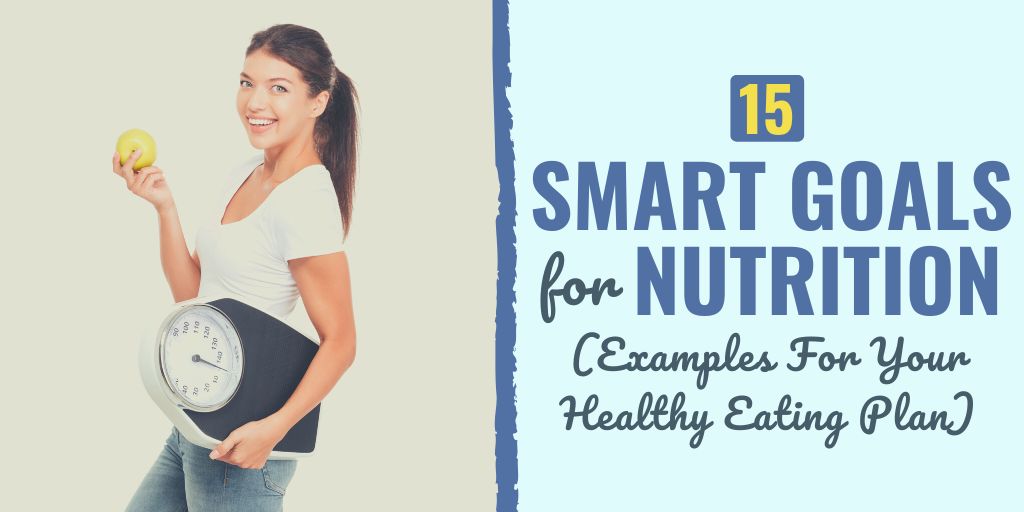There might be affiliate links on this page, which means we get a small commission of anything you buy. As an Amazon Associate we earn from qualifying purchases. Please do your own research before making any online purchase.
Congratulations! You’ve decided to improve your health in one of the most effective ways possible– through the foods and drinks that you put in your body.
Now what?
To have a successful healthy eating plan, you need to start by setting specific and attainable goals that lay out a solid plan that will help you get healthy.
After all, vague goals such as, “eat healthier” or “limit sugar intake” are sure to end in discouragement because you won’t be able to tell if you’re doing well on your goal journey or when you’ve reached the finish line.
Let’s say you’ve finished your first week of ‘eating healthier’ and you had three salads since you made the initial promise to yourself. Did you accomplish your goal? Did those salads replace some otherwise unhealthy meal choices or did you just order a side salad to go along with the pizza that you would have eaten anyway?
There’s really no telling if you were successful or not.
So, instead of having meaningless goals that you can’t measure, an effective strategy is to use SMART goals, which are defined by their components: Specific, Measurable, Achievable, Relevant, and Time-bound.
Your SMART goals allow you to clearly define exactly what you want your outcome to be and how you will know when you’ve reached it.
It’s extremely important to have goals–and having good goals is harder than it may seem at face value. It’s easy to recognize some things that you want for your future, but to verbalize the steps you have to take to get to the finish line takes thought and time. But having goals is important to your success in life, and it’s worth the effort to create them the right way.
But what is a SMART goal?
We have talked about SMART goals a lot on this site, but in this article, we will go over a refresher of what these goals look like and the components that each of them have. Then, we will look at seven examples of SMART goals for healthy eating and nutrition.
Let’s start by taking a look at these special goals.
What Is a SMART Goal?
A constructive strategy for setting goals is the SMART goal method. SMART goals help you define exactly what you want to accomplish and how you will know what your progress is along the way. A good way to write your SMART goal statements is to consider the following:
Is it specific? Exactly what are you trying to accomplish? Rather than simply saying you will eat healthier, you could say that at least 50% of every meal will consist of fresh fruits and vegetables.
Can you measure your goal? Knowing how far you’ve come at any point along the way will keep you on track. You can use a journal or an app to measure your progress–but you have to make sure that your goal is written in a way that it can be measured.
For example, if you want to eat more whole foods, assign a number to that goal so you can count and make a tally mark for each whole food you eat.
Is your goal achievable? Is your goal too hard or too easy? Do you have the skills and resources that you need to be successful? For example, if you want to eat foods that were grown at least 100 miles from where you live to ensure they’re nutrient-rich, is there a farmers’ market near you where you can buy these foods? Or, if you want to grow your own fruits and vegetables, do you have a yard?
You want your goal to challenge you, but you don’t want it to be out of reach. If you start working toward your goal and you find it’s more difficult than you had anticipated, you can always adjust your plan. And the same goes for goals that end up being too easy. Start small and go from there.
Is your goal relevant? What are your long-term goals and what’s your ultimate vision for your life? Having a relevant goal will keep you motivated because you will feel yourself making progress toward something bigger.
Is your goal time-bound? Without a deadline, you won’t have the push that you need to get started and keep working. With a time-bound goal, you have a starting point, a frequency, and a deadline.
If you’re aiming to improve your nutrition, you may want to start with one small change that will last two weeks, and then add on something else. After all, you’re trying to make a lifestyle change, not find a quick fix. And there will always be room for improvement when it comes to tweaking your diet.
So, you may be wondering, “Why should I create SMART goals?” Well, I’m glad you asked. Let’s take a look at some of the benefits that SMART goals boast.
Benefits of Making SMART Goals
Here are some benefits that SMART goals have over the typical vague goals that people often make:
Let’s take a look at some examples of SMART goals that you can use to create a healthy eating plan and improve your nutrition.
15 SMART Goals for Nutrition Examples For Your Healthy Eating Plan
1. Replace Processed Nutrition Bars
“For the next two weeks, I will replace the processed nutrition bars that I bring to work for a snack with real, whole foods such as almonds, fruit, yogurt, and peanut butter.”
S: This SMART goal statement presents how this person will revamp the snacks they eat on a regular basis by replacing processed “health” foods with whole foods.
M: Each snack this person brings to work for the next two weeks counts as one unit of measure.
A: This is a healthy, achievable goal.
R: Whole foods are dense with nutrition, while processed foods are more energy dense (read: high in sugar and calories). This is a relevant goal because your body needs natural vitamins and minerals to maintain optimal health.
T: The deadline for this goal is in two weeks.
2. Eat a Well-Rounded Breakfast
“Every weekday morning until the 4th of July I will take 20 minutes to eat a well-rounded breakfast that will satisfy me and keep me energized throughout the day. Each breakfast will include whole grains, fiber, protein, fruits or vegetables, and healthy fat. This will stop my normal routine of being starving by 10:00, eating an unhealthy snack, and getting tired at 2:00.”
S: This statement lays out a very specific plan detailing what the goal-setter will do, when, how often, and why.
M: Each well-rounded breakfast eaten until the 4th of July counts as one unit of measure.
A: This is an achievable goal that anyone who is trying to improve their nutrition should consider.
R: Studies show that eating a healthy breakfast makes a huge impact on your overall well being.
T: The deadline for this goal is July 4th.
3. Pack Lunch for Work
“I will pack a lunch for work every day for the next 30 days to prevent myself from splurging on restaurant food during the week.”
S: This statement declares a plan for this person to avoid eating at restaurants for lunch for at least a month.
M: Each lunch this person packs and eats for the next 30 days counts as one unit of measure out of 30.
A: This is an achievable goal (and it will save you money).
R: Studies show that packing your lunch reduces your caloric intake by up to 35%, making this goal relevant.
T: The deadline for this goal is in 30 days
4. Limit Soda Intake
“I will limit my soda intake by choosing sparkling water on 4 out of 5 occasions until the end of the summer, which will increase my hydration and decrease the harmful effects that soda has on my body.”
S: This person will choose sparkling water over soda 80% of the time.
M: This is measured by the number of occasions on which this person drinks sparkling water over soda.
A: This is an attainable goal.
R: Limiting soda intake comes along with a wide variety of health benefits.
T: This is an ongoing goal to benefit one’s health.
5. Make a Meal Plan
“I will spend an hour every Sunday night for the rest of the year making a meal plan for the upcoming week and prepping any food items that I can ahead of time. This will reduce the amount of processed ‘grab and go’ food that I consume.”
S: This goal statement lays out an action plan to reduce the amount of processed food this person eats throughout the hustle and bustle of the week.
M: This person will spend 20 minutes per week for the rest of the year creating a meal plan for the upcoming week.
A: This is an achievable goal.
R: This is a relevant goal for people who want to reduce their junk food intake.
T: The deadline for this SMART goal is the end of every Sunday and the end of the year.

6. Measure Food Portions
“I will measure out my food portions for the next six weeks to gain a better understanding of what a serving size actually is.”
S: This SMART goal details how this person is going to learn about portion control as a part of their healthy eating plan.
M: This person will take the time to measure all of their portion sizes for the next six weeks.
A: This is an achievable goal.
R: This is a relevant goal for anyone who is learning about healthy eating.
T: The deadline for this SMART goal is in six weeks.
7. Eat the Rainbow
“I will eat the rainbow every day for the next two months so my body gets the nutritional variety that it needs for optimal functioning.”
S: This goal statement communicates an eight-week eating plan that will make sure the goal-setter is eating a well-rounded and nutritional diet.
M: For eight weeks, this person will eat foods at least once every day that are all six colors of the rainbow.
A: This is an achievable goal with some proper planning.
R: This is a relevant goal for a healthy eating plan.
T: The deadline for this SMART goal is in two months, and will hopefully be adopted as a new habit.
8. Practice Mindful Eating
“I will not eat while watching TV for two months and practice mindful eating instead to avoid consuming extra calories.”
S: This goal statement communicates an eight-week plan to intentionally consume meals without distractions, particularly in front of the TV, where it's easy to overeat.
M: For eight weeks, this person will enjoy meals at the dinner table.
A: This achievable goal requires discipline.
R: This is a relevant goal for avoiding consuming extra calories while being distracted by having a meal while watching TV.
T: The deadline for this SMART goal is in two months.
9. Use a Food Tracker
“I will use a device to track my foods and drinks every day for the next two months to gain some visibility in how closely I’m adhering to a healthy diet.”
S: This goal statement communicates an eight-week plan of tracking my foods and drinks via an app or spreadsheet that will make sure the goal-setter is aware of their diet.
M: For eight weeks, this person will enter the amounts of each food and drink consumed throughout each day.
A: This is an achievable goal as this person will create a spreadsheet or download an app and keep track daily.
R: This is a relevant goal for creating visibility into what the goal-setter is truly consuming, so they may make changes if necessary to achieve optimum health.
T: The deadline for this SMART goal is in two months, and will show a true picture and trends of this person’s diet.

10. Eat Half, Save Half
“For the next two months, when ordering a meal in a restaurant, I’ll eat half and save half for another meal to reduce calories.”
S: This goal statement will make sure the goal-setter is eating fewer calories while enjoying a restaurant meal.
M: This person will eat on half a meal while saving the other half each time they order from a restaurant menu for the next eight weeks.
A: This is an easily achievable goal as the goal-setter can ask for a to-go container as they are ordering a meal and split it before consuming the meal.
R: This is a relevant goal for decreasing calories even while allowing this person the privilege of enjoying a restaurant meal.
T: The deadline for this SMART goal is in two months, and after which the person will decide whether to make this a habit.
11. Drink ½ Your Weight in Ounces of Water Daily
“I will drink ½ my weight in ounces of water every day for the next two months, so my body stays well hydrated and less hungry.”
S: This goal statement communicates an eight-week plan that will make sure the goal-setter is consuming a healthy amount of water for maintaining and/or losing weight.
M: For eight weeks, this person will throughout each day, beginning with 8oz before each meal and supplementing water intake throughout the day.
A: This is an achievable goal with always keeping a bottle or tumbler of water nearby.
R: This is a relevant goal as part of a healthy diet.
T: The deadline for this SMART goal is in two months, and may continue as a way of life.
12. Eat Fish Once Per Week
“I will eat a type of fish, salmon, tuna, etc., once a week for the next two months, so my body gets the nutritional benefit from omega-3 fatty acids provided by the fish.”
S: This goal statement communicates an eight-week plan that will make sure the goal-setter is eating seafood to contribute to a healthy diet.
M: For eight weeks, this person will eat seafood at least once every week.
A: This is an achievable goal, as one day each week can be designated as “fish day”.
R: This is a relevant goal for adding healthy omega-3 fatty acids into the diet for heart and brain health.
T: The deadline for this SMART goal is in two months, and may become a new habit.
13. Limit Processed Foods
“I will limit pre-packaged and pre-cooked foods every day for the next month, so my body gets less sugar, carbohydrates, and preservatives.”
S: This goal statement communicates a four-week plan to reduce processed foods so that the goal-setter consumes fewer calories than those in sugary, preservative-laden, high-carb foods.
M: For four weeks, this person will eat non-processed foods for each meal every day.
A: This is an achievable goal with mindful meal planning.
R: This is a relevant goal for eliminating or reducing unhealthy foods.
T: The deadline for this SMART goal is in one month, and may be adopted as a habit.
14. Limit Starchy Foods
“I will limit my consumption of starchy foods, like potatoes, beans, and certain high starchy foods every day for the next month so my body gets used to a healthier diet.”
S: This goal statement communicates a four-week eating plan that will ensure the goal-setter is eating fewer starchy foods, which will help control weight gain and blood sugar.
M: For four weeks, this person will eliminate high-starchy foods.
A: This is an achievable goal with some proper planning.
R: This is a relevant goal for heart health and maintaining a healthy weight.
T: The deadline for this SMART goal is one month, and will hopefully be adopted as a new habit.
15. Make a Healthy Grocery List
“I will make a list before weekly grocery shopping, so my body gets more nutritional foods and less sugary treats.”
S: This goal statement helps to ensure a nutritional diet with fewer unhealthy impulse purchases.
M: Before each grocery shopping trip, this person will create a list of foods and ingredients for optimal health.
A: This is an achievable goal with advanced planning.
R: This is a relevant goal for consuming healthy foods regularly.
T: The deadline for this SMART goal is weekly.
Final Thoughts on SMART Goals for Nutrition Examples
Living by a healthy eating plan can be tough, especially because a lot of us would live off of bar snacks and desserts, if we could. The idea of giving up some of the foods that we love the most may feel a bit overwhelming at first, but once you get into the habit of eating nutritious foods, you will see how much better you feel overall on a daily basis and you will lose your appetite for your former favorites.
You can adjust these SMART goal examples to your own healthy eating journey by adjusting the numbers–and as soon as you start seeing progress, I guarantee you’ll feel a renewed sense of motivation to grow your healthy habits to other areas of your life as well.
And if you want more SMART goal ideas and examples, be sure to check out these blog posts:
- 13 SMART Fitness Goals Examples That Will Motivate You
- 8 SMART Goals Examples for Weight Loss
- 5 SMART Goal Examples to Practice Daily Self-Care
Finally, if you want to take your goal-setting efforts to the next level, check out this FREE printable worksheet and a step-by-step process that will help you set effective SMART goals.

Connie Stemmle is a professional editor, freelance writer and ghostwriter. She holds a BS in Marketing and a Master’s Degree in Social Work. When she is not writing, Connie is either spending time with her 4-year-old daughter, running, or making efforts in her community to promote social justice.


